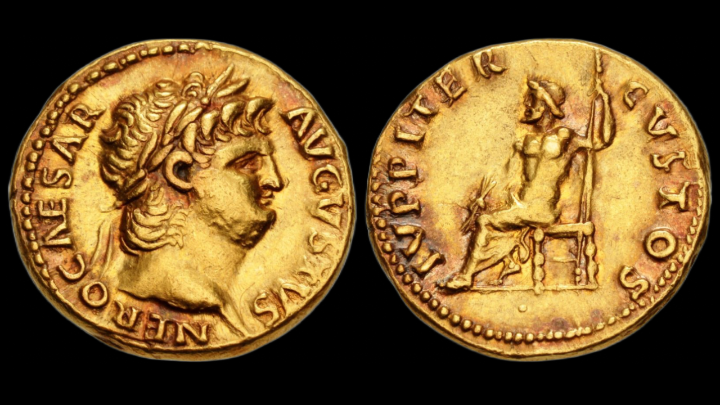In the vast corpus of Roman imperial numismatics, certain coins distill the tensions, hopes, and fears of an entire era. The aureus of Nero featuring Jupiter Custos on the reverse perfectly embodies this fusion of imperial propaganda and the quest for divine legitimacy.
A gold coin struck in the urgency of power
This aureus, minted in Rome, measures 18 mm in diameter, weighs 7.33 g, and has a die axis of 6 h. Its condition is Good VF, with a superb violet-red patina characteristic of aurei from the famed Boscoreale Hoard discovered in 1895. This distinctive hue, highly sought-after by connoisseurs, adds aesthetic appeal to an already prestigious piece.
🔸 Obverse:
The obverse features a laureate portrait of Nero facing right, accompanied by the inscription "NERO CAESAR AVGVSTVS." The expression is both imperial and impassive, conveying the image of an all-powerful ruler rooted in the Augustan tradition of personal rule.
🔸 Reverse:
The reverse depicts Jupiter Custos, guardian of the emperors. The god sits to the left, bare-chested, with a cloak draped around his lower limbs. In his right hand, he holds a thunderbolt, symbol of his divine might, and in his left, a vertical scepter. The inscription "IVPPITER CVSTOS" refers to the supreme protector of the Roman state.
Every element in this design is loaded with meaning. Amid the political unrest of AD 64–65, the iconography was far from random — it was a carefully chosen statement of strategy and reassurance.

Nero, Jupiter, and the fear of conspiracy
The aureus of Nero with Jupiter Custos is directly tied to one of the most dramatic episodes of his reign: the Pisonian Conspiracy. This widespread plot, launched in AD 65, aimed to overthrow Nero and install Gaius Calpurnius Piso in his place. Among the conspirators were some of Nero’s closest associates: the philosopher Seneca, the poet Lucan, Petronius, and several other influential courtiers.
To Nero, betrayal from within his own circle came as a profound shock. In explaining his survival and the swift collapse of the plot, he claimed divine intervention. It wasn’t mere chance, he insisted, but Jupiter himself—guardian of Rome and its emperors—who had saved him. Hence the issuance of this aureus type bearing the image of Jupiter Custos, symbol of divine justice and imperial stability.
This moment marked a turning point. From then on, Nero became increasingly distrustful and authoritarian. Imperial ideology took on a more religious tone, and coins like this one became near-liturgical instruments of propaganda.
A coin at the crossroads of history and propaganda
The aureus of Nero with Jupiter Custos is more than just a crisis-era coin: it stages the emperor’s attempt to reassert authority through divine sanction, presenting himself as Jupiter’s chosen, protected by the gods against traitors and dissenters.
The example presented here is of exceptional quality, further enhanced by its rare patina. It was struck using the same dies as the specimen sold at CNG Auction 111 (lot 667) — a notable detail underscoring its historical and numismatic significance. This coin was ultimately sold for $17,000.
📩 If you're looking for this coin – or any other exceptional piece – get in touch with us. At AV Janus, we will find it for you.